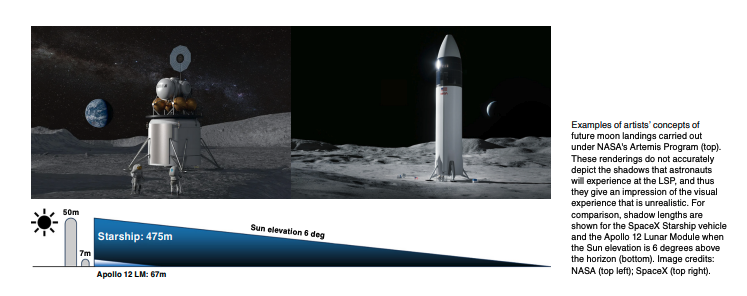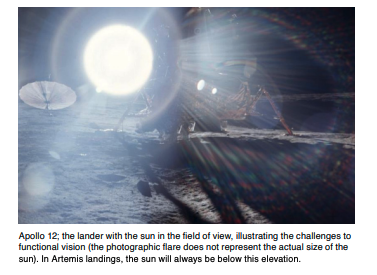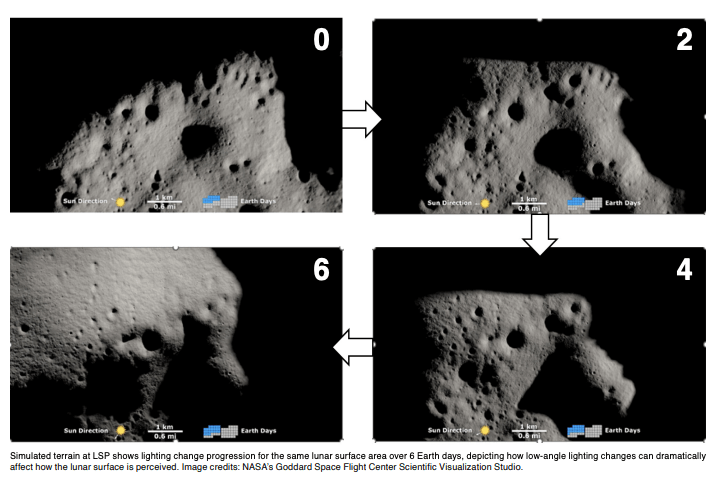
Characterizing the Visual Experience of Astronauts at the Lunar South Pole

Humans are returning to the Moon—this time, to stay. Because our presence will be more permanent, NASA has selected a location that maximizes line-of-sight communication with Earth, solar visibility, and access to water ice: the Lunar South Pole (LSP). While the Sun is in the lunar sky more consistently at the poles, it never rises more than a few degrees above the horizon; in the target landing regions, the highest possible elevation is 7°. This presents a harsh lighting environment never experienced during the Apollo missions, or in fact, in any human spaceflight experience. The ambient lighting will severely affect the crews’ ability to see hazards and to perform simple work. This is because the human vision system, which despite having a high-dynamic range, cannot see well into bright light and cannot adapt quickly from bright to dark or vice versa. Functional vision is required to perform a variety of tasks, from simple tasks (e.g., walking, operating simple tools) through managing complex machines (e.g., lander elevator, rovers). Thus, the environment presents an engineering challenge to the Agency: one that must be widely understood before it can be effectively addressed.
In past NASA missions and programs, design of lighting and functional vision support systems for extravehicular activity (EVA) or rover operations have been managed at the lowest program level. This worked well for Apollo and low Earth orbit because the Sun angle was managed by mission planning and astronaut self-positioning; helmet design alone addressed all vision challenges. The Artemis campaign presents new challenges to functional vision, because astronauts will be unable to avoid having the sun in their eyes much of the time they are on the lunar surface. This, combined with the need for artificial lighting in the extensive shadowing at the LSP, means that new functional vision support systems must be developed across projects and programs. The design of helmets, windows, and lighting systems must work in a complementary fashion, within and across programs, to achieve a system of lighting and vision support that enables crews to see into darkness while their eyes are light-adapted, in bright light while still dark-adapted, and protects their eyes from injury.
Many of the findings of the assessment were focused on the lack of specific requirements to prevent functional vision impairment by the Sun’s brilliance (which is different from preventing eye injury), while enabling astronauts to see well enough to perform specific tasks. Specifically, tasks expected of astronauts at the LSP were not incorporated into system design requirements to enable system development that ensures functional vision in the expected lighting environment. Consequently, the spacesuit, for example, has flexibility requirements for allowing the astronauts to walk but not for ensuring they can see well enough to walk from brilliant Sun into a dark shadow and back without the risk of tripping or falling. Importantly, gaps were identified in allocation of requirements across programs to ensure that the role of the various programs is for each to understand functional vision. NESC recommendations were offered that made enabling functional vision in the harsh lighting environment a specific and new requirement for the system designers. The recommendations also included that lighting, window, and visor designs be integrated.
The assessment team recommended that a wide variety of simulation techniques, physical and virtual, need to be developed, each with different and well-stated capabilities with respect to functional vision. Some would address the blinding effects of sunlight at the LSP (not easily achieved through virtual approaches) to evaluate performance of helmet shields and artificial lighting in the context of the environment and adaptation times. Other simulations would add terrain features to identify the threats in simple (e.g., walking, collection of samples) and complex (e.g., maintenance and operation of equipment) tasks. Since different facilities have different strengths, they also have different weaknesses. These strengths and limitations must be characterized to enable verification of technical solutions and crew training.



